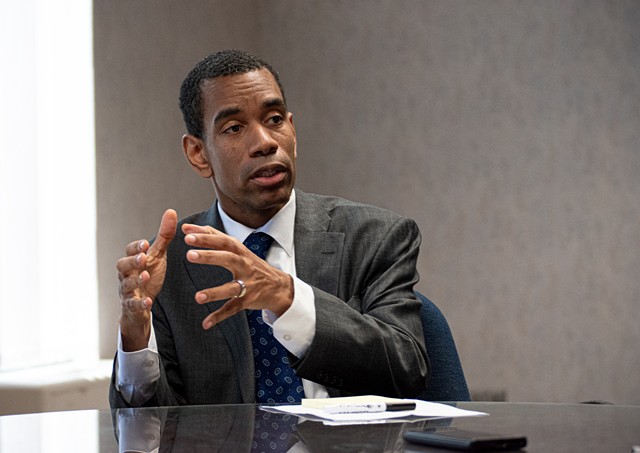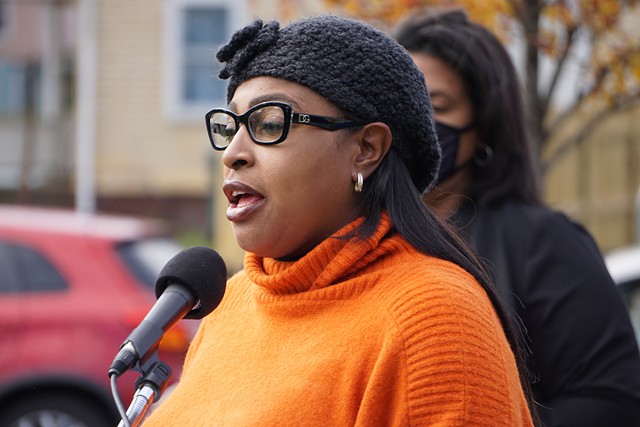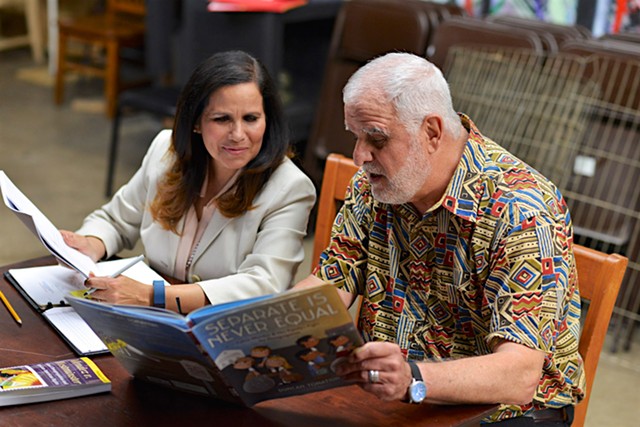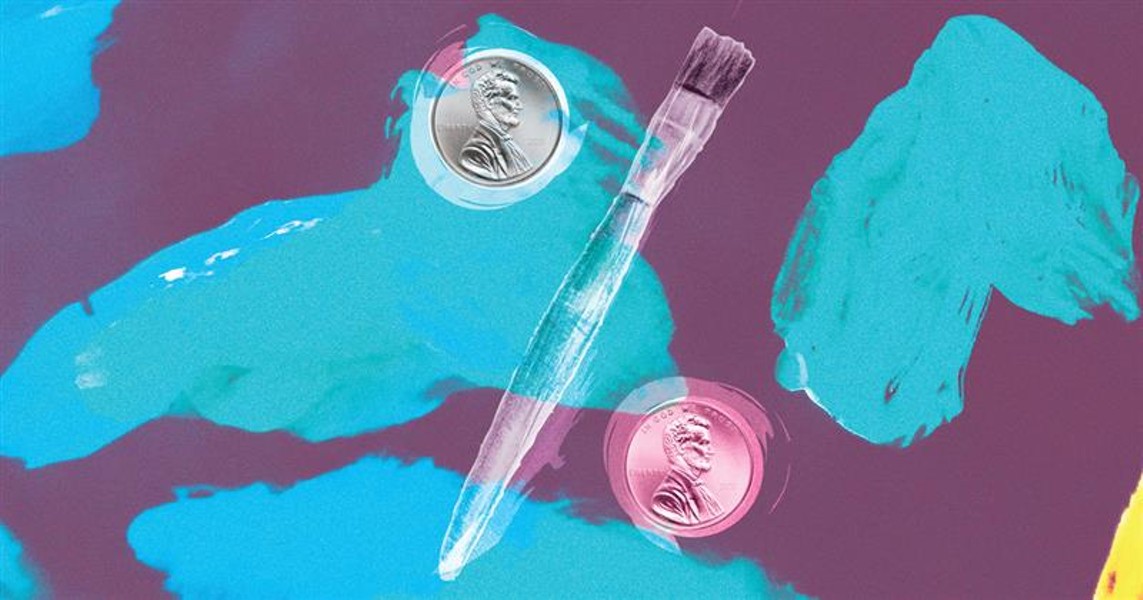Rochester officials, who fondly refer to our city as “a city of the arts,” and for good reason, appear to finally be getting serious about funding the arts.
But will their plan leave the launch pad this time?
American cities that care about being more fun and interesting places to live have for decades invested a small portion of their budgets for certain municipal construction projects in public artworks.
These percent-for-art ordinances, as they are known, typically require 1 percent of construction costs be set aside for the purchase of works of art to either complement the site or be placed elsewhere in the city.
Philadelphia was the first city in the United States to adopt such a law in 1959. Scores of cities, counties, and states have since followed, and they have been remarkably successful at coughing up the money.
Then there is Rochester, which has next to nothing to show for a percent-for-art policy it enacted 15 years ago.
Now, Mayor Malik Evans’s administration is trying to, as the manager of city planning put it at a recent City Council committee meeting, “jump-start the initiative.”
It is about time.
RELATED: If Rochester is a 'City of the Arts,' why don't we fund the arts?
Rochester was already a latecomer to the percent-for-arts movement when the administration of Mayor Robert Duffy and the City Council enacted our law in 2007. The ordinance required the city to designate to art 1 percent of the cost of construction projects in which the city spent at least $1 million.
 The city had a couple of years to prepare. Under the law, it was supposed to start setting the money aside in 2009.
The city had a couple of years to prepare. Under the law, it was supposed to start setting the money aside in 2009.
But just when the money was to start flowing, the Duffy administration was scratching its head over basic details of just how this whole percent-for-art thing that other cities had been implementing successfully for decades should work.
Some of the administration’s questions and comments submitted into the City Council record that year included:
“How is the city share for a project calculated?”
“How is the 1 percent tracked over the several years of a project and when is it determined that the commitment has been met?”
“Tying the art funding to a specific project adds a significant amount of up-front time and work.”
In the end, the City Council amended the law slightly at Duffy’s request to allow the city to pay for its commitment to art using a variety of revenue streams at its disposal, and to give the city more flexibility in choosing where the art would go.
From there, though, the law was all but abandoned.
In 10 of the years since, the city has neglected to set aside or spend money tied to the percent-for-art law, according to the Evans administration.
“It didn’t really get the backing that it needed to become fully implemented,” said Dana Miller, the city’s commissioner of neighborhood and business development, who was on the City Council at the time.
“That’s really the bottom line,” he said. “In any process, you can get everything ready, but until you hit that launch button, it just sits there on the pad.”
Former Mayor Lovely Warren resuscitated the percent-for-art law late in her term when she referenced it in her administration’s “Rochester 2034 Plan,” a blueprint for the future of the city, and assembled the Arts and Creative Community Committee, an advisory panel of people in the community with stakes in a variety of art forms.
 Last month, the City Council kept up the CPR when it amended the law again.
Last month, the City Council kept up the CPR when it amended the law again.
This time, the changes codified, among other things, that a minimum of 25 percent of the percent-for-art fund be spent on art annually, and established a new option for supporting “non-capital art,” such as temporary art exhibitions, performance art, and arts education programs.
The Evans administration has set aside $236,000 to start spending now, with $100,000 dedicated to murals and another $100,000 to fund a “public art installation program.” Both of those initiatives have been put out to bid.
RELATED: Amid tensions with artists, city looks to spend $200K on public art
The remaining $36,000 is to help fund the development of an arts and culture plan for Rochester. In simple terms, that means the creation of a legitimate arts commission that can shepherd projects and advise the city on funding.
Every community in the country that is serious about public art has one. Rochester should, too.
To facilitate that, the administration has assembled a team of city workers from several departments to advance art-related efforts and collaborate with the advisory committee.
Annette Ramos, of the Rochester Latino Theatre Company and one of 14 community arts leaders on the committee, said conversations with the city have been “meaningful and in-depth,” and expressed optimism that percent-for-art would finally get off the ground.
“Any city that thinks only the government can lead arts is really cutting their nose off to spite their face,” Ramos said. “It is not a budget person, it is not a communications person. It’s truly the arts sector leaders and advocates that can assure and instill a sense of value. I’m positive we’ve never been this far along.”
 Percent-for-art won’t be a windfall for public art. The Evans administration figures there only are a half-dozen or so capital construction projects a year that exceed $1 million, and estimates that will translate to anywhere from $150,000 to $270,000 going to art annually.
Percent-for-art won’t be a windfall for public art. The Evans administration figures there only are a half-dozen or so capital construction projects a year that exceed $1 million, and estimates that will translate to anywhere from $150,000 to $270,000 going to art annually.
But it could be a steady revenue stream — if the city has the political will to put the money aside.
City Councilmember Mitch Gruber questioned the administration’s stomach for following through when the legislation amending the percent-for-art law went through the council’s Finance Committee.
The answer he got from Budget Director Michael Burns was underwhelming.
“Is there some kind of reporting mechanism that we can develop to really make sure that what we’re doing here is what’s done, so 14 years from now whoever replaces . . . us don’t have to have the same conversation?” Gruber asked.
“Yeah, so, I think we can give that some thought and come up with an appropriate way to bring the full light of day to what we’re doing,” Burns replied.
Until that happens, percent-for-art waits for blast off.
David Andreatta is CITY's editor. He can be reached at [email protected].
But will their plan leave the launch pad this time?
American cities that care about being more fun and interesting places to live have for decades invested a small portion of their budgets for certain municipal construction projects in public artworks.
These percent-for-art ordinances, as they are known, typically require 1 percent of construction costs be set aside for the purchase of works of art to either complement the site or be placed elsewhere in the city.
Philadelphia was the first city in the United States to adopt such a law in 1959. Scores of cities, counties, and states have since followed, and they have been remarkably successful at coughing up the money.
Then there is Rochester, which has next to nothing to show for a percent-for-art policy it enacted 15 years ago.
Now, Mayor Malik Evans’s administration is trying to, as the manager of city planning put it at a recent City Council committee meeting, “jump-start the initiative.”
It is about time.
RELATED: If Rochester is a 'City of the Arts,' why don't we fund the arts?
Rochester was already a latecomer to the percent-for-arts movement when the administration of Mayor Robert Duffy and the City Council enacted our law in 2007. The ordinance required the city to designate to art 1 percent of the cost of construction projects in which the city spent at least $1 million.

- PHOTO BY JACOB WALSH
- Mayor Malik Evans, pictured in October 2021, says his administration is looking to fund the city's 'percent-for-art' policy after 15 years of neglect.
But just when the money was to start flowing, the Duffy administration was scratching its head over basic details of just how this whole percent-for-art thing that other cities had been implementing successfully for decades should work.
Some of the administration’s questions and comments submitted into the City Council record that year included:
“How is the city share for a project calculated?”
“How is the 1 percent tracked over the several years of a project and when is it determined that the commitment has been met?”
“Tying the art funding to a specific project adds a significant amount of up-front time and work.”
In the end, the City Council amended the law slightly at Duffy’s request to allow the city to pay for its commitment to art using a variety of revenue streams at its disposal, and to give the city more flexibility in choosing where the art would go.
From there, though, the law was all but abandoned.
In 10 of the years since, the city has neglected to set aside or spend money tied to the percent-for-art law, according to the Evans administration.
“It didn’t really get the backing that it needed to become fully implemented,” said Dana Miller, the city’s commissioner of neighborhood and business development, who was on the City Council at the time.
“That’s really the bottom line,” he said. “In any process, you can get everything ready, but until you hit that launch button, it just sits there on the pad.”
Former Mayor Lovely Warren resuscitated the percent-for-art law late in her term when she referenced it in her administration’s “Rochester 2034 Plan,” a blueprint for the future of the city, and assembled the Arts and Creative Community Committee, an advisory panel of people in the community with stakes in a variety of art forms.

- PHOTO BY GINO FANELLI
- Mayor Lovely Warren, pictured a a news conference in October 2020, resuscitated the city's moribund 'percent-for-art' law and efforts to form an arts commission by including both in her administration's "Rochester 2034 Plan."
This time, the changes codified, among other things, that a minimum of 25 percent of the percent-for-art fund be spent on art annually, and established a new option for supporting “non-capital art,” such as temporary art exhibitions, performance art, and arts education programs.
The Evans administration has set aside $236,000 to start spending now, with $100,000 dedicated to murals and another $100,000 to fund a “public art installation program.” Both of those initiatives have been put out to bid.
RELATED: Amid tensions with artists, city looks to spend $200K on public art
The remaining $36,000 is to help fund the development of an arts and culture plan for Rochester. In simple terms, that means the creation of a legitimate arts commission that can shepherd projects and advise the city on funding.
Every community in the country that is serious about public art has one. Rochester should, too.
To facilitate that, the administration has assembled a team of city workers from several departments to advance art-related efforts and collaborate with the advisory committee.
Annette Ramos, of the Rochester Latino Theatre Company and one of 14 community arts leaders on the committee, said conversations with the city have been “meaningful and in-depth,” and expressed optimism that percent-for-art would finally get off the ground.
“Any city that thinks only the government can lead arts is really cutting their nose off to spite their face,” Ramos said. “It is not a budget person, it is not a communications person. It’s truly the arts sector leaders and advocates that can assure and instill a sense of value. I’m positive we’ve never been this far along.”

- PHOTO PROVIDED
- Annette Ramos, of the Rochester Latino Theatre Company, and theater Don Bartalo, of hummingbird theatre co., wrote the play "Separate is Never Equal" in 2016. The play was based on the children's book by Duncan Tonatiuh
But it could be a steady revenue stream — if the city has the political will to put the money aside.
City Councilmember Mitch Gruber questioned the administration’s stomach for following through when the legislation amending the percent-for-art law went through the council’s Finance Committee.
The answer he got from Budget Director Michael Burns was underwhelming.
“Is there some kind of reporting mechanism that we can develop to really make sure that what we’re doing here is what’s done, so 14 years from now whoever replaces . . . us don’t have to have the same conversation?” Gruber asked.
“Yeah, so, I think we can give that some thought and come up with an appropriate way to bring the full light of day to what we’re doing,” Burns replied.
Until that happens, percent-for-art waits for blast off.
David Andreatta is CITY's editor. He can be reached at [email protected].

